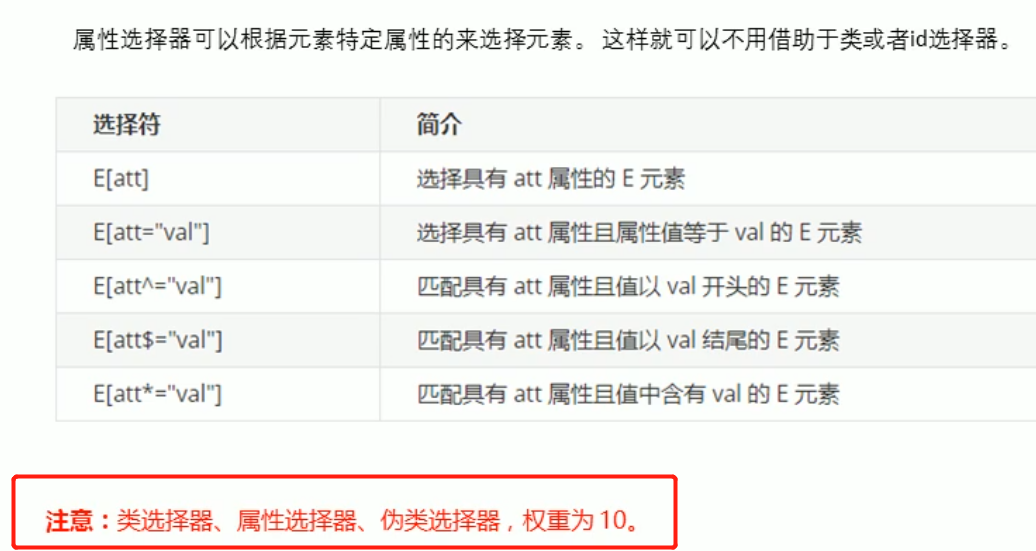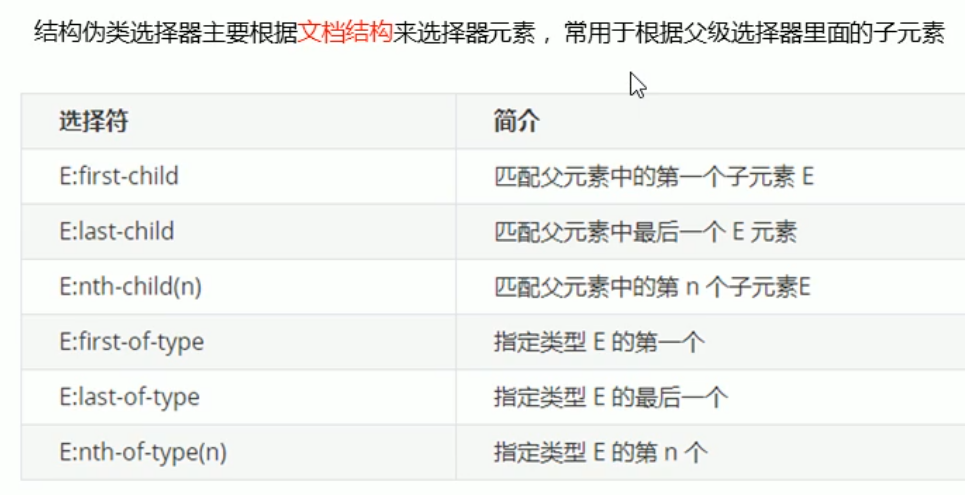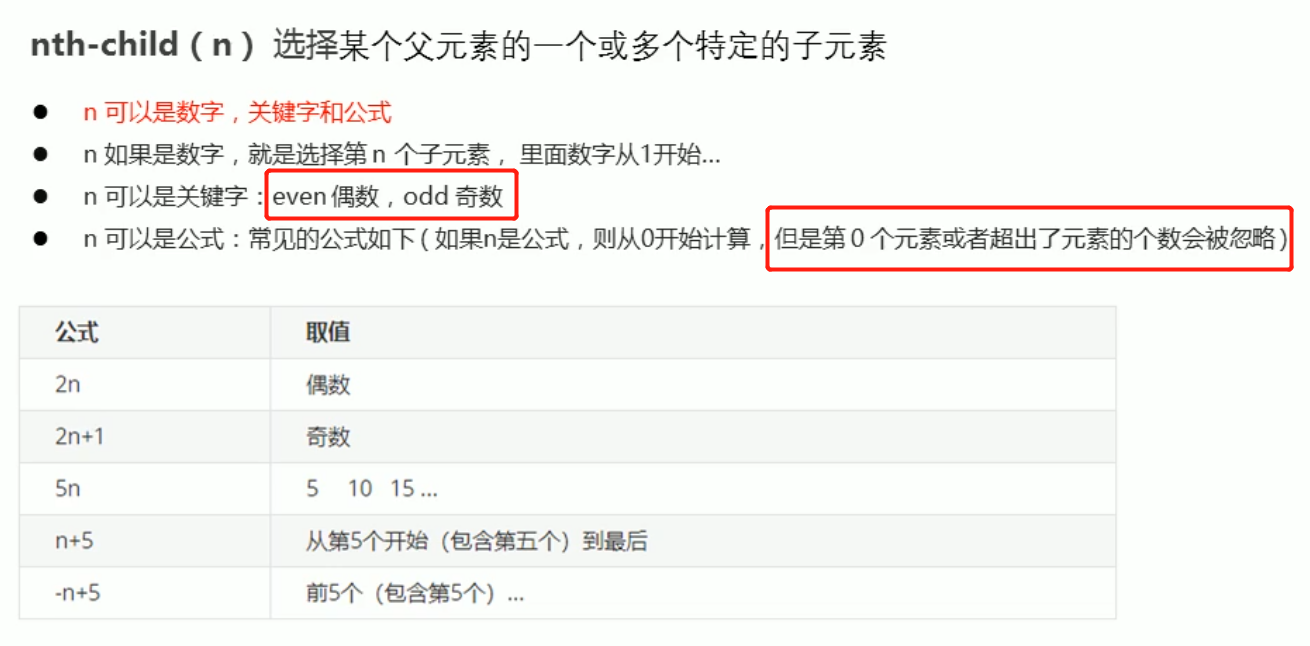1.属性选择器

属性选择器在基础选择器之后添加中括号[ ]来选择具有该属性的元素。并且可以选择自定义的属性。
<body><!-- 1.使用属性选择器可以不借助于id或者class选择器 --><input type="text" value="用户名"><input type="text"><!-- 2.属性选择器还可以选择属性等于某个值的元素 --><input type="password" value="11111"><!-- 3.选择某个属性中包含某个值的元素 --><input type="button" value="按钮"><!-- 4.属性选择器也能选择自定义的属性 --><input type="text" value="我要变色!" colorChange><style>/* 必须是input 但是同时具有value这个属性 选择这个元素使用 [] */input[value] {color: pink;}input[type=password] {color: pink;}input[type*=but] {color: skyblue;}/* 属性选择器也能选择自定义的属性,colorChange是我自定义的属性,不是html自带的 */input[colorChange] {color: springgreen;}</style></body>
比如米哈游官网的属性选择器,就用了很多自定义的属性选择器:
.lang-select-item[data-v-dfb510b0] 就是选择类名为lang-select-item并且具有data-v-dfb510b0这个属性的元素。
权重问题
2.结构伪类选择器


2.1 首先来看前三个
其中 first-child 和 last-child是选择第一个和最后一个子元素,比较简单,主要重点学习 nth-child(n)
nth-child(n) 选择器(重要)
nth 就代表第几个子元素,其中的括号内可以写数字、关键字和公式
实例
<body>
<style>
/* 1.把所有的偶数孩子选出来 */
ul li:nth-child(even) {
background-color: yellow;
}
/* 2.把所有的奇数孩子选出来 */
ul li:nth-child(odd) {
background-color: purple;
}
/* 3.nth-child(n)也能写公式 其中n从0开始 每次加1 括号内必须是n 不能是其他的字母,如果只写n代表选择所有的孩子 */
/* ul li:nth-child(n) {
background-color: rgb(153, 186, 216);
} */
/* 4.nth-child(2n) 就表示选择了0,2,4...所有的偶数孩子,等价于even */
ol li:nth-child(2n) {
background-color: rgb(153, 186, 216);
}
/* 同理 2n-1 就是奇数 */
ol li:nth-child(2n-1) {
background-color: rgb(218, 95, 235);
}
</style>
<ul>
<li>我是第1个子元素</li>
<li>我是第2个子元素</li>
<li>我是第3个子元素</li>
<li>我是第4个子元素</li>
<li>我是第5个子元素</li>
<li>我是第6个子元素</li>
</ul>
<ol>
<li>我是第1个子元素</li>
<li>我是第2个子元素</li>
<li>我是第3个子元素</li>
<li>我是第4个子元素</li>
<li>我是第5个子元素</li>
<li>我是第6个子元素</li>
</ol>
</body>
特性
nth-child在执行时,会给所有孩子排序,无论是什么标签类型,并且在使用复合选择器执行时会先查看nth-child的值,再去看前边选择器的值,举个例子:
section div:nth-child(1) //此处我们直觉的语义应该是section里的第一个div孩子,但事实是错的
//正确的执行顺序:先看section底下的第一个孩子,再去看是否是div,若不是则选择失败。
<section>
<p>你好</p>
<div>世界</div>
</section>
<style>
section div:nth-child(1) { /*这个选择器是失效的,因为section的第一个子孩子不是div元素
color: red;
}
</style>
2.2 再来看后面三个关于type的
上面提到了nth-child()反直觉的语法顺序,所以才有了nth-of-type来纠正这个错误:
first-of-type last-of-type nth-of-type()在使用和规则上与上三个基本相同,用法也一样,只是nth-of-type在处理复合选择器时的顺序与nth-child不同:nth-of-type会先去看前面指定懂得元素,再去标号按顺序查找。

CSS总还有很多其他的伪类,以上只是常用的六种,以下是所有的伪类选择器:
所有 CSS 伪类(重要)
| 选择器 | 例子 | 例子描述 |
|---|---|---|
| :active | a:active | 选择活动的链接。 |
| :checked | input:checked | 选择每个被选中的 元素。 |
| :disabled | input:disabled | 选择每个被禁用的 元素。 |
| :empty | p:empty | 选择没有子元素的每个 元素。 |
| :enabled | input:enabled | 选择每个已启用的 元素。 |
| :first-child | p:first-child | 选择作为其父的首个子元素的每个 元素。 |
| :first-of-type | p:first-of-type | 选择作为其父的首个 元素的每个 元素。 |
| :focus | input:focus | 选择获得焦点的 元素。 |
| :hover | a:hover | 选择鼠标悬停其上的链接。 |
| :in-range | input:in-range | 选择具有指定范围内的值的 元素。 |
| :invalid | input:invalid | 选择所有具有无效值的 元素。 |
| :lang(language) | p:lang(it) | 选择每个 lang 属性值以 “it” 开头的 元素。 |
| :last-child | p:last-child | 选择作为其父的最后一个子元素的每个 元素。 |
| :last-of-type | p:last-of-type | 选择作为其父的最后一个 元素的每个 元素。 |
| :link | a:link | 选择所有未被访问的链接。 |
| :not(selector) | :not(p) | 选择每个非 元素的元素。 |
| :nth-child(n) | p:nth-child(2) | 选择作为其父的第二个子元素的每个 元素。 |
| :nth-last-child(n) | p:nth-last-child(2) | 选择作为父的第二个子元素的每个 元素,从最后一个子元素计数。 |
| :nth-last-of-type(n) | p:nth-last-of-type(2) | 选择作为父的第二个 元素的每个 元素,从最后一个子元素计数 |
| :nth-of-type(n) | p:nth-of-type(2) | 选择作为其父的第二个 元素的每个 元素。 |
| :only-of-type | p:only-of-type | 选择作为其父的唯一 元素的每个 元素。 |
| :only-child | p:only-child | 选择作为其父的唯一子元素的 元素。 |
| :optional | input:optional | 选择不带 “required” 属性的 元素。 |
| :out-of-range | input:out-of-range | 选择值在指定范围之外的 元素。 |
| :read-only | input:read-only | 选择指定了 “readonly” 属性的 元素。 |
| :read-write | input:read-write | 选择不带 “readonly” 属性的 元素。 |
| :required | input:required | 选择指定了 “required” 属性的 元素。 |
| :root | root | 选择元素的根元素。 |
| :target | #news:target | 选择当前活动的 #news 元素(单击包含该锚名称的 URL)。 |
| :valid | input:valid | 选择所有具有有效值的 元素。 |
| :visited | a:visited | 选择所有已访问的链接。 |




